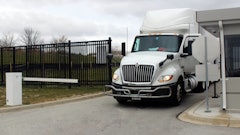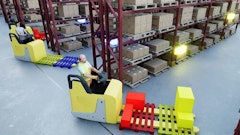VITAL STATS
Located in the heart of the nation.
Population: 300,000
Land Area: 555 square miles
Incentives: Topeka is actively developing economic opportunities for both existing and new companies.
Topeka is home to some well--known and major companies in the food industry. Easy access to major north--south and east--west interstates, coupled with the city’s proximity to major food growers, makes locating in Topeka a good choice for food companies.
"It’s truly the breadbasket in the Midwest, and many food manufacturers have been located here for longer than 75 years," says Doug Kinsinger, president and CEO of the Greater Topeka Chamber of Commerce.
Highway and rail accessibility is readily available, with I--70 for east--west access and I--35 and I--75 offering excellent north--south access. "This is really a major trucking hub, and Kansas City is just under an hour away for companies looking for intermodal facilities," Kinsinger says.
The Union Pacific and BNSF railroads are very active in the city, with about 120 trains a day departing and arriving. "Topeka is one of the original headquarters for the old Santa Fe Railroad, and BNSF still operates a major rail yard here, employing more than 1,000 people here in our community," says Kinsinger.
The city is actively developing economic opportunities for both existing and new companies. A local option sales tax, in force through 2012, will stimulate economic development and maintain and expand the transportation infrastructure with a $60 million commitment through 2012. Kinsinger says $5 million is already earmarked each year for economic development and $9 million will be used for local roads and bridges.
"These revenues are put into a fund which will be used to attract new businesses, acquire land, improve utilities, prepare sites and market our region," Kinsinger says.
Topeka is also considering the construction of a water pre--treatment facility to be operated by the city. "We have several large users of water; the cost of water and of its pretreatment has increased over the years," says Kathy Moellenberndt, vice president and director for economic development. The effluent from the pre--treatment facility would be biodegradable and the idea is to use the effluent to water local landscaping within the Commerce Park, thereby reducing wastewater treatment costs.
The city offers financial incentives and tax credits designed to help incoming companies reduce some of their up--front costs and accelerate their time lines. "We can provide a property tax exemption of up to 10 years and a tax exemption up to 80 percent or more, depending on the circumstances," Moellenberndt says.
Being in a state Enterprise Zone also helps. "Companies can qualify for a tax credit based on new jobs they create, as well as on capital investments they make," Moellenberndt explains. "In addition, if a company were to pay higher--than--average wages, it would qualify for a larger tax credit that could equate up to 10 percent of their capital investments."
Another program critical to the economic vitality of the region is workforce training. "This is a top issue, even around the country," Moellenberndt continues. "We place a lot of value on training and we offer a number of training programs, as well as skills upgrading, for employees in area companies."
A few top food manufacturing and processing companies in Topeka are Reser’s Fine Foods and Frito--Lay. Reser’s, for example, began operating in Topeka in the early 1990s with 35 employees and a 50,000--square--foot facility. Today, the company operates four production plants there and employs more than 600 people. Frito--Lay operates an 850,000-- square--foot manufacturing facility and a 250,000--square--foot warehouse and employs 850 people.
Kinsinger says the cost of living is low and the region offers numerous cultural amenities and opportunities to enjoy the outdoor life.
Next Stop: Kansas City
Sixty miles east of Topeka lies Kansas City, a true transportation hub of particular interest to anyone in the food distribution industry. Kansas City is one of few U.S. cities with three intersecting interstate highways: I--70, I--29 and I--35. The city is also a bustling rail hub, with service from five Class 1 railroads operating 300 daily freight arrivals and departures.
"The city is fast becoming a major player in the international trade corridor for the flow of goods not only throughout the country, but to Mexico and Canada as well," says Greg Kindle, president of Southwest Johnson County Economic Development.
Eleven regulated barge lines service Kansas City on the Missouri River and Kansas City International Airport is one of the nation’s largest airport Foreign Trade Zones. Kansas City’s New Century Air Center is a key contact point for anyone in the food industry looking to serve major metropolitan areas through distribution and logistics projects, says Kindle.
New Century is particularly well suited for companies in the food industry and hosts a number of food manufacturers already, with room to grow.
New Century Air Center is located in a 2,300--acre industrial park with easy access to interstates, an airport and rail service. "It has its own rail switching capabilities and sits on the BNSF mainline, which connects us to the ports of Los Angeles and Long Beach, where a lot of food products are shipped from," Kindle says.
Currently, Unilever Best Foods, Danisco, CFS West Foods and Kerry Sweet Ingredients are among some of the food companies located in the park. "Unilever, which makes I Can’t Believe It’s Not Butter and Country Crock, can ship its products anywhere in the country from here within one or two days by truck," Kindle says. "In fact, Unilever is the only margarine facility in North America that has the room to expand operations because of the acreage we have available here. We can also enhance our rail capabilities in any way to meet the needs of any company that might want to locate here."
Three other key issues for food manufacturers and processors are the availability of potable water, excellent sewage capabilities and affordable electricity. "There are parts of the country that don’t have these capabilities and, even though they might have the land, workforce and the other necessary components, if you don’t have good water it will be tough for these companies," Kindle says. He adds the existing food companies continue to attract other companies involved in the food supply chain.
The area also supports a lot of cold storage and frozen storage warehousing space, says Chris Gutierrez, president of Kansas City SmartPort. "Throughout our region we have about 15 major DCs for food--related products," Gutierrez says. He adds Tyson Foods operates a 450,000--square--foot refrigerated and frozen warehouse and Sysco Foods has a 500,000--square--foot DC in the area. ADM and ConAgra also operate food manufacturing facilities here. "We are literally a bread basket center, with our region leading the nation in corn, wheat, soybean and other agricultural production."
Kindle points out that the State of Kansas is an Enterprise Zone, offering tax credits for qualifying businesses. For example, CFS Foods took advantage of a five--year 50--percent local tax abatement to help get its facility operating. "They also receive a number of training grants for their employees from the state," he says.
New Century Air Center operates through a land--lease model. "We are talking about a lease that is about 14 cents a square foot and that’s less than most of our neighboring communities in development fees," continues Kindle. Since it’s a long--term commitment, a company does not have to take out a lot of debt and land--leases are considered operational costs, so it goes right to the bottom line, Kindle says. d
-------------------------------------
Unilever Foods North America
New Location After Network Consolidation
"This is a great location for us because of our proximity to I--35 for north--south transportation and I--70 for east--west transportation," says Ian Ricketts, plant manager for Unilever Foods North America located in the New Century Air Center in Kansas City. "Since the vast majority of our distribution is by truck, this is an excellent location for us."
Some popular brands of margarines and spreads produced by Unilever include Country Crock, Imperial, I Can’t Believe It’s Not Butter, Take Control and Promise. "We also make a wide range of private label products and some foodservice products," Ricketts says, adding the plant produces about 1 million pounds of product every day.
On the inbound side, Unilever receives its main ingredient––soybean oil––by road tanker. "We receive anywhere from 10 to 20 tankers a day," Ricketts says.
The company does little intermodal––only about four or five truckloads a week, shipping to a sister factory in San Francisco.
"The issue with rail is our products are all refrigerated and lead time is just seven days. So we are able to run a made--to--order business plan," says Ricketts.
This Unilever plant handles a greater portion of the country than its four other sister plants. "This area offers everything a distribution or supply chain manager can envision," Ricketts says. "Not only do we distribute to our region, but we also make a large number of unique SKUs or single--sourced SKUs which we supply to our sister factories and they in turn supply to their customers’ DCs. This is how our supply chain works."
Ricketts adds another advantage New Century offers is its proximity to the city proper. "We are far enough away not to have the disadvantages of the congested roads," he says. Unilever chose this location for its strategic location after it consolidated its nationwide network of factories and DCs.
"Each of our five strategically located plants operates as a sourcing site for products and as its own DC," explains Ricketts, noting the New Century facility is about 200,000 square feet. "So we don’t supply into a large DC––we supply directly to customers and into their DCs."
This business plan means the company’s supply chain is short.
"Another good thing about this business park is it’s ripe for growth with lots of available land," Ricketts says. "It’s very well managed and the services are great. I am happy we are here."
---------------------------------
U.S. Foodservice
Topeka Chosen For Its Close Connections To Customers
When U.S. Foodservice needed to find a location to expand its national market, it found a 300,000--square--foot DC available in Topeka. "We chose this location because of the good highways and we use truck transportation exclusively," says Kevin Craig, division president. "From here it’s a straight shot into Kansas City and Wichita. We can also pull triples on the turnpike in Kansas and that helps us cut our costs when we run our relay systems into Kansas City."
On the inbound side of its business, U.S. Foodservice receives finished products from manufacturers like Heinz, Campbell’s and General Mills. The company operates more than 80 other DCs throughout the country, but the Topeka facility distributes to foodservice customers such as hotels, restaurants, hospitals and universities, primarily in east--central Kansas and west--central Missouri. Its market in this region includes about a 200--mile radius with 1.75 million consumers.
"This location was chosen primarily because of its proximity to the markets," Craig says. "Because we are so heavily involved in distribution, it’s important for us to be as close to the population hubs and transportation corridors as possible. It also fits in with our model of responding fast because if you are 300 miles away from the population centers, it’s tough to do next--day deliveries."
U.S. Foodservice’s customers usually place their orders the day before they expect delivery. "The foodservice industry is very fast paced," Craig says. "If you are running a hotel with a big catering event, you don’t have a lot of time to react and that quick reaction time funnels down to us."
The company is close to I--70 for east--west access and I--35 and I--29 for north--south transportation. "There is a spur nearby for I--35 and I--29 goes right into Kansas City, which is only 60 miles away, so there are good carriers who want to haul from here," says Craig.
When the company first moved into Topeka, it received tax credits and other incentives for creating job growth in the region. "One thing that really helped us when we started here were the educational and training incentives," explains Craig. "Since we were starting up a different kind of operation that no one else around had in terms of foodservice distribution, there was really no trained workforce. So we were able to get some nice incentives from the state that allowed us to offset the cost of training."
As for other food--related companies thinking about a move to Topeka, Craig says it’s a good choice.
"There’s a lot of agriculture here in the Midwest so there’s great access to food products whether you are a manufacturer or processor," he says. "And, in terms of beef, there’s a lot available and because it’s a heavy product, your freight costs can be reduced because you don’t have to haul it for long distances."
Craig also points to the region’s amenities––such as family entertainment including a zoo, outdoor activities and cultural events offered at nearby Kansas State University and the University of Kansas.
















